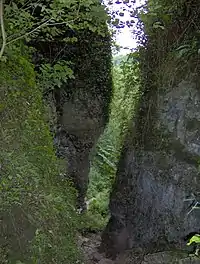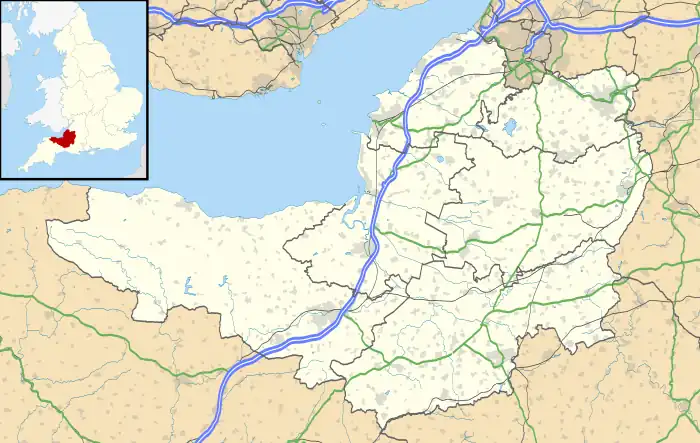| Site of Special Scientific Interest | |
 | |
 Location within Somerset | |
| Location | Somerset |
|---|---|
| Grid reference | ST525485 |
| Coordinates | 51°14′02″N 2°40′55″W / 51.234°N 2.682°W |
| Interest | Biological |
| Area | 156.8 acres (0.635 km2; 0.2450 sq mi) |
| Notification | 1952 |
| Natural England website | |
Ebbor Gorge is a limestone gorge in Somerset, England, designated and notified in 1952 as a 63.5-hectare (157-acre) biological Site of Special Scientific Interest in the Mendip Hills. It was donated to the National Trust in 1967 and is now managed by Natural England as a national nature reserve.
The gorge was cut mostly into the Clifton Down Limestone, part of the Lower Carboniferous Pembroke Group, by water. The site was occupied by humans in the Neolithic Era and their tools and flint arrow heads have been discovered, along with pottery from the Bronze Age. There are also fossils of small mammals from the Late Devensian. The nature reserve provides a habitat for a variety of flora and fauna, including flowers, butterflies and bats.
Geology
Ebbor Gorge lies on the southwest-facing slope of the Mendip Hills and consists of a steep-sided ravine cut into 350-million-year-old Carboniferous Limestone of the Dinantian. The gorge was cut into Clifton Down Limestone by meltwater in the Pleistocene Epoch.[1][2] The lowest part of the gorge is formed in the Namurian Quartzitic Sandstone Group and the South Wales Lower Coal Measures, over which younger limestones have been thrust to the north-east, as demonstrated by the BGS maps (1:50,000 sheet 280, Wells). An example of the rare mineral mendipite was found at the head of the gorge.[3]
A stream issuing to the west of the site runs down the tributary valley of Hope Wood before joining the main gorge. The original watercourse which may have cut the gorge into the limestone became diverted underground and now emerges at Wookey Hole Caves to form the River Axe.[4]
History
Various caves within the gorge were inhabited by neolithic people from which flint tools are held in the Wells and Mendip Museum.[5][6][7] One particularly fine flint flake can be seen in the museum at King John's Hunting Lodge in Axbridge.[8] Human and animal bones from the Neolithic were recovered from Outlook Cave in 1907.[9] Bones from the Palaeolithic have been found at Savory's Hole.[10]
Several caves occur within the Gorge, of which Bridged Pot and Gully Cave provide some of the best Late Devensian small-mammal assemblages known from Britain. Most of the deposits remain in situ and include steppe pika, Arctic lemming, Norway lemming, various voles, red deer and reindeer.[11][12][13][14] Bronze Age finds include pottery from the Beaker culture,[15] a stone axe and flint knife.[16]
Current use

A 40-hectare (99-acre) area of the gorge is owned by the National Trust, and managed by Natural England as a national nature reserve.[17][18] The land was donated to the National Trust by Mrs G.W. Hodgkinson, in 1967, in memory of Winston Churchill.[19] The site was purchased in 1931 by Wookey Hole Caves Ltd.[20]
The site is close to Wookey Hole village and caves and offers views across the Somerset Levels to Glastonbury Tor and beyond. There are three marked trails of varying lengths around the steeply wooded gorge, the longest being 3 kilometres (1.9 mi) long,[7] the shortest of which is suitable for wheelchair users.[21]
Biology and ecology

Because of the ecology of the area 63.5 hectares (157 acres) was designated as a biological Site of Special Scientific Interest in 1952.[11] The ground flora is indicative of the calcareous nature of the site, with dog's mercury (Mercurialis perennis) being locally dominant. Many of the associated species are characteristic of ancient woodland. Wood anemone (Anemone nemorosa) and common bluebell (Hyacinthoides non-scripta) are both locally abundant. The valley of the main gorge is humid and provides ideal conditions for fungi and ferns. It contains a substantial assemblage of bryophytes with over 120 species recorded including the nationally rare Bryum canariense and the very rare Amblystegiella confervoides.[11]
The varied age and canopy structure of woodland encourages a high diversity of butterflies, nationally scarce species including the white-letter hairstreak (Strymonidia walbum) and high brown fritillary (Fabriciana adippe), while species such as the chalkhill blue (Lysandra coridon) and brown argus (Aricia agestis) occur on the limestone grassland.[22] Greater horseshoe bats (Rhinolophus ferrumequinum) and lesser horseshoes (Rhinolophus hipposideros) regularly use sites in the Gorge as hibernacular roosts.[11] The site also supports birds of prey and a few red deer.[23]
References
- ↑ "Wookey Hole and Ebbor Gorge". British Geological Survey. Retrieved 22 December 2013.
- ↑ Donovan, D.T. (1988). "The late pleistocene sequence at Wells, Somerset" (PDF). Proceedings of the University of Bristol Speleological Society. 18 (2): 241–257.
- ↑ Toulson, Shirley (1984). The Mendip Hills: A Threatened Landscape. Victor Gollanz Ltd. p. 32. ISBN 978-0-575-03453-2.
- ↑ Smith, David Ingle (1975). Limestone and Caves of the Mendip Hills. David & Charles. p. 120. ISBN 978-0-7153-6572-4.
- ↑ Lewis, Jodie (1998). "The Everton flint collection in Wells Museum" (PDF). Proceedings of the University of Bristol Speleological Society. 21 (2): 141–148.
- ↑ Brown, Graham. "Dispersed settlements on the southern Mendip escarpment. The earthwork evidence" (PDF). Research Department Report Series no 72-2008. English Heritage. Archived from the original (PDF) on 24 December 2013. Retrieved 22 December 2013.
- 1 2 "Ebbor Gorge NNR". Natural England. Retrieved 19 May 2014.
- ↑ Bond, Clive Jonathon (2013). "The later upper palaeolithic open sites and settlement trajectories. The evidence from the Mendip Hills, south-west Britain". Notae Praehistoricae. 33: 179–192.
- ↑ Historic England. "Outlook Cave (1010711)". National Heritage List for England. Retrieved 15 February 2015.
- ↑ Historic England. "Savory's Hole (1012061)". National Heritage List for England. Retrieved 22 February 2015.
- 1 2 3 4 "Ebbor Gorge" (PDF). English Nature. Retrieved 22 December 2013.
- ↑ Papworth, Martin. "Deep Time in Ebbor Gorge". Archeology. National Trust. Retrieved 22 December 2013.
- ↑ "Wolves and wildcats: surviving the end of the last ice age in Somerset". Harrow and Hillingdon Geological Society. Retrieved 19 May 2014.
- ↑ "Learning & Leading Fieldwork Apprentices" (PDF). Royal Geographical Society. Retrieved 19 May 2014.
- ↑ "Bridged Pot Shelter, Ebbor Gorge, Wookey, Somerset". A Gazetteer of English Caves, Fissures and Rock Shelters Containing Human Remains. University of Sheffield. Archived from the original on 4 February 2012. Retrieved 22 December 2013.
- ↑ "Bridged Pot Hole, Ebbor Gorge". Somerset Historic Environment Record. Somerset County Council. Retrieved 4 October 2014.
- ↑ "Ebbor Gorge NNR". Natural England. Archived from the original on 5 June 2014. Retrieved 31 January 2010.
- ↑ "Things to see and do". National Trust. Retrieved 21 December 2013.
- ↑ Leete-Hodge, Lornie (1985). Curiosities of Somerset. Bodmin: Bossiney Books. p. 24. ISBN 0-906456-98-3.
- ↑ "Beauty Spot Known to Few Bristolians". Western Daily Press. 17 July 1931. p. 4. Retrieved 4 October 2014 – via British Newspaper Archive.
- ↑ Toulson, Shirley (1984). The Mendip Hills: A Threatened Landscape. Victor Gollanz Ltd. pp. 128–129. ISBN 978-0-575-03453-2.
- ↑ "Ebbor Gorge". United Kingdom Butterfly Monitoring Scheme. Archived from the original on 19 May 2014. Retrieved 19 May 2014.
- ↑ Toulson, Shirley (1984). The Mendip Hills: A Threatened Landscape. Victor Gollanz Ltd. p. 128. ISBN 978-0-575-03453-2.
External links
- Natural England website for the Ebbor Gorge NNR